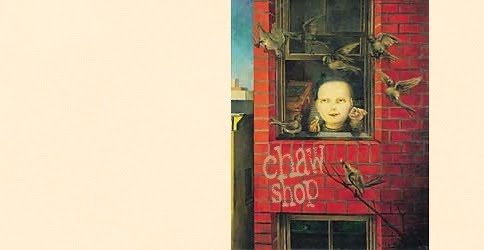Knock knock.
Who's there?
Banana.
Banana who?
Knock knock.
Who's there?
Banana.
Banana who?
Knock knock.
Who's there?
Orange.
Orange who?
Orange you glad I didn't say banana again?
Unfortunately for the adults in my life, the above is the first joke I learned as a small child, and for awhile, it was the only one I told. I still remember the satisfaction it gave me. There's a power in the structure of a joke: the set up (knock knock), the complication (which is this case is drawn out for an extra two beats: banana, banana, orange), and then the resolution ("Orange you glad I didn't say banana again?"). In this most basic sense, this is the structure of a conventional story.
In the mid-60's, a young man was dating a girl named Lorraine that his parents hoped he would marry. However, he was in love with a hippy chick who played folk guitar and called herself "Clearly." Despite his feelings he allowed himself to be pushed into an engagement with Lorraine. Fortunately for him, on the day before their wedding, Lorraine unthinkingly stepped in front of a bus and was killed instantly. Upon hearing the news, the young man declared, "I can see Clearly now, Lorraine is gone!"
The similarity between jokes and fables or parables is, to me, obvious. Both "explain away" weird imagery or bizarre events with a punchline that all at once reveals the organizing force behind the narrative, a force that, up until that point, has gone unnoticed. The moral of, say, the ant and the grasshopper ("Be prepared for lean times") may not be funny, but it reduces these characters and their situation as a tool we can apply to our own lives, in the same way that "I can see Clearly now, Lorraine is gone," reduces the proto-characters in the love triangle to the homophonious sounds of their names. The last line releases us from our emotional investment in the dear departed Lorraine in the same way the moral releases us from our investment in the dear departed grasshopper.
Immediately the fairy gave a stroke with her wand, and in a moment all that were in the hall were transported into the prince's dominions. His subjects received him with joy. He married Beauty, and lived with her many years, and their happiness -- as it was founded on virtue -- was complete.
We expect a similar kind of release in the endings of longer stories. The fairy tale's "happily ever after" is the most obvious example. An ending of "happily ever after" moves the characters back from the specificity of a human situation unfolding in space and time into an abstract, purely fictive zone. In the Disney film version of Beauty and the Beast, this is visually literalized: at the end the animated characters we've been watching for nearly the whole film freeze for all time into a still image made of stained glass. But this is also true in many stories intended for adults. Jane Austen's novels retreat into stasis: at the end of Sense and Sensibility, we are told in the last line that the two sisters, fundementally opposed throughout the novel, "live without disagreement between themselves, or producing coolness between their husbands." And modern novels too: Joe Meno's The Boy Detective Fails concludes with the (up till now) solitary, nostalgic, and clinically depressed title character declaring, "It's all over now. I'm not young anymore. No more adventures, no more mysteries, no more secrets," to which his lady love gives the suitably vague response, "We'll make our own secrets now, maybe." After endings like these, further action isn't just omitted; it's actually impossible under the terms of the story we've just witnessed.
I'm not categorically dismissing endings of this punchline- or "happily ever after"-variety, because I think they can be remarkably effective. But they do bear more resemblance to the structure of a joke than to the structure (or rather non-structure) of "real life." So why is it that some readers assume that the "meaning" of a story comes entirely at the end, in the same way the "meaning" of a riddle comes from its solution?

No comments:
Post a Comment